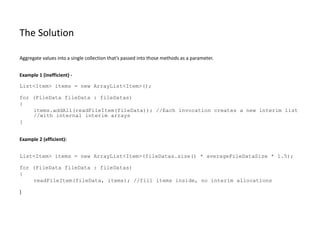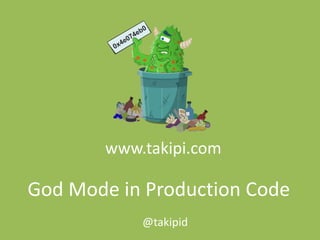The document outlines five coding hacks to reduce garbage collector overhead in Java applications, focusing on memory management strategies. Key solutions include avoiding implicit string allocations, planning list capacities, using efficient primitive collections, adopting streaming over in-memory buffers, and aggregating lists to prevent excessive interim allocations. Implementing these practices can significantly enhance performance and resource utilization in high-scale applications.

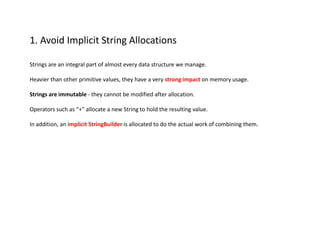
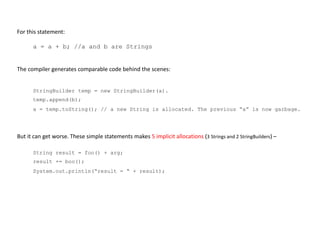

![2. Plan List Capacities
Collections such as ArrayLists, HashMaps and TreeMaps are implemented using underlying Object[] arrays.
Like Strings (themselves wrappers over char[] arrays), arrays are also immutable.
The obvious question then becomes - how can we add/put items in collections if their underlying array’s size is
immutable?
The answer is obvious as well - by allocating more implicit arrays.](https://image.slidesharecdn.com/5codinghackstoreducegcoverhead-130723030510-phpapp02/85/5-Coding-Hacks-to-Reduce-GC-Overhead-5-320.jpg)
![Let’s look at this example -
List<Item> items = new ArrayList<Item>();
for (int i = 0; i < len; i++)
{
Item item = readNextItem();
items.add(item);
}
The value of len determines the ultimate size of items once the loop finishes.
len is unknown to the constructor of the ArrayList which allocates an initial Object[]with a default size.
Whenever the capacity of the array is exceeded, it’s replaced with a new array of sufficient length, making the
previous array garbage.
If the loop executes > 100 times you may be forcing multiple arrays allocations + collections.](https://image.slidesharecdn.com/5codinghackstoreducegcoverhead-130723030510-phpapp02/85/5-Coding-Hacks-to-Reduce-GC-Overhead-6-320.jpg)

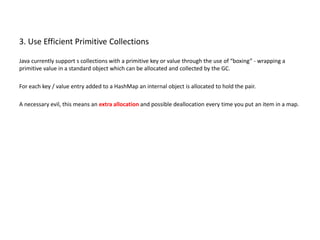
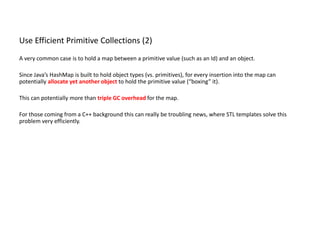


![Use Streams Instead of In-memory Buffers (2)
A common thing to do is read the data into memory using a ByteArrayInputStream or ByteBuffer and pass that
on to the deserialization code.
This can be a bad move, as you’d need to allocate and later deallocate room for that data in its entirety while
constructing objects out of it .
Since the size of the data can be of unknown size, you’ll have to allocate and deallocate internal byte[] arrays
to hold the data as it grows beyond the initial buffer’s capacity.](https://image.slidesharecdn.com/5codinghackstoreducegcoverhead-130723030510-phpapp02/85/5-Coding-Hacks-to-Reduce-GC-Overhead-12-320.jpg)


